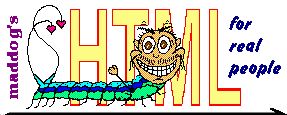 Chapter 2, Lesson 1
Chapter 2, Lesson 1 Chapter 2, Lesson 1
Chapter 2, Lesson 1If you already know how to build a minimal HTML-compliant document, you can skip this lesson.
Every HTML document should have a "skeleton" framework which serves as a minimum document which the receiving browser can interpret.
Framing the entire document is the <HTML></HTML> tag pair, which basically tells the receiving browser to treat this document as an 'HTML' type entity. Notice that since this is a tag pair, t he first tag serves to tell the browser when to "turn this feature ON", and the last tag tells it when to "turn that feature OFF". [Human pairs have been known to act this way, too...]. Notice that the "turner-off-er" has the forward slash embedded in i t. [no comment on the human analog]. This is true of all closing tags. By the way, it doesn't make any difference whether the tags are upper or lower case, but for convention's sake, we'll capitalize them. [Later, we'll inventory the freezer...].
The next tag pair, right after the <HTML> tag, helps the browser differentiate between the 'header' information and the main 'body' of the document. For this we use the <HEAD> </HEAD> tag pair.
Inside the header we will place the title (and other information we haven't covered yet) that helps define the document's context. Since the title of the document is essential (it's displayed prominently by the browser), we'll make it part of our skeleton, placing it within the header, using the tag pair <TITLE> </TITLE>.
The last element of our skeleton framework is the <BODY> </BODY> tagpair. Between this start and end tag, we'll place the guts of our document. [As of now, we're gutless].
Let's look at the actual text we'll use as the skeleton framework for all our HTML documents, our "source":
![]()
<HTML> <HEAD> <TITLE> </TITLE> </HEAD> <BODY> </BODY> </HTML>
![]()
![]()
As you can plainly see in the simulated demo, the document does absolutely nothing. That's why we call it a "skeleton"; it's a place to start - a framework - and when you add some meat, you end up with a body that might actually be useful! That's exactl y what we'll do in the next lesson!